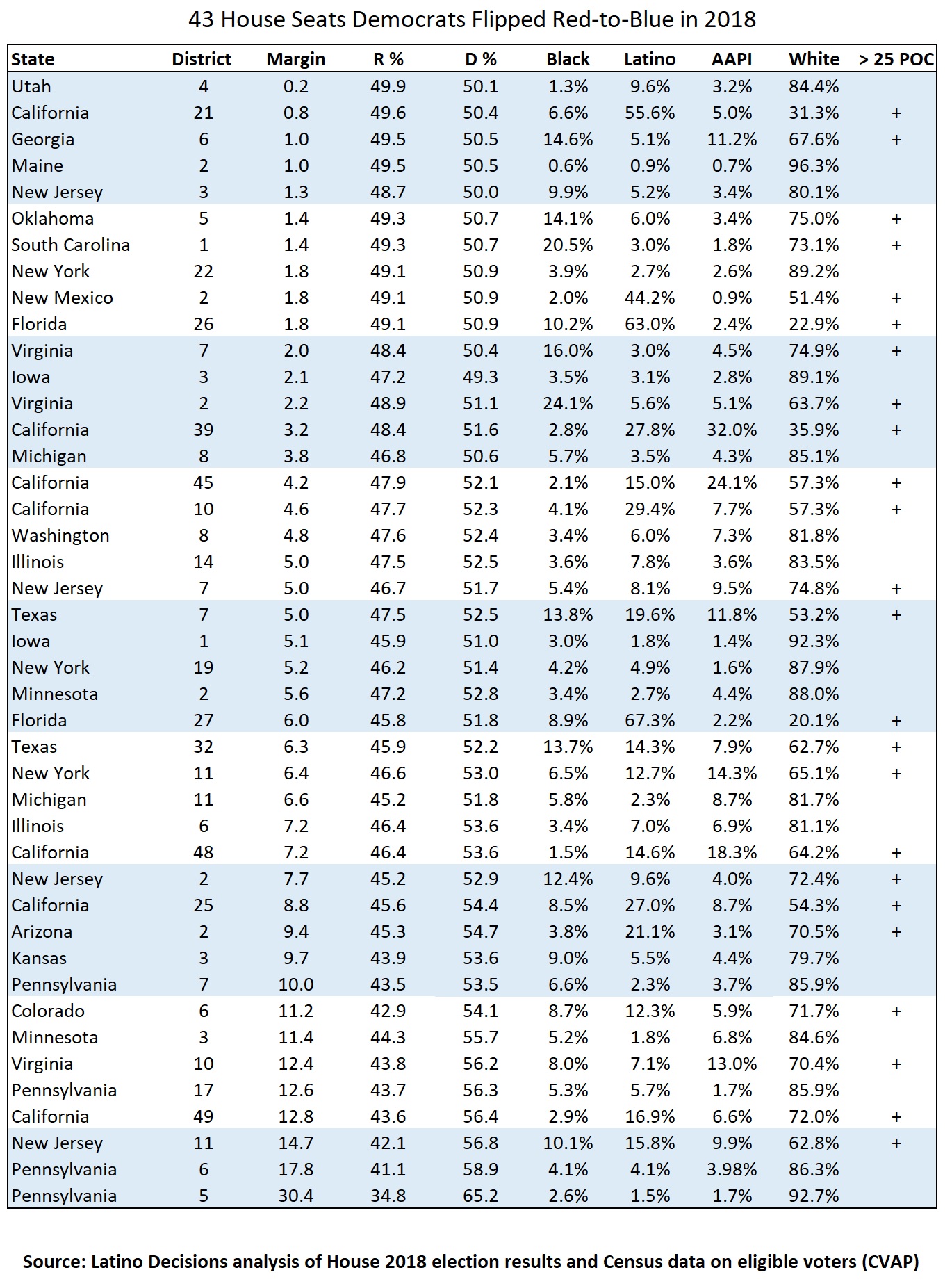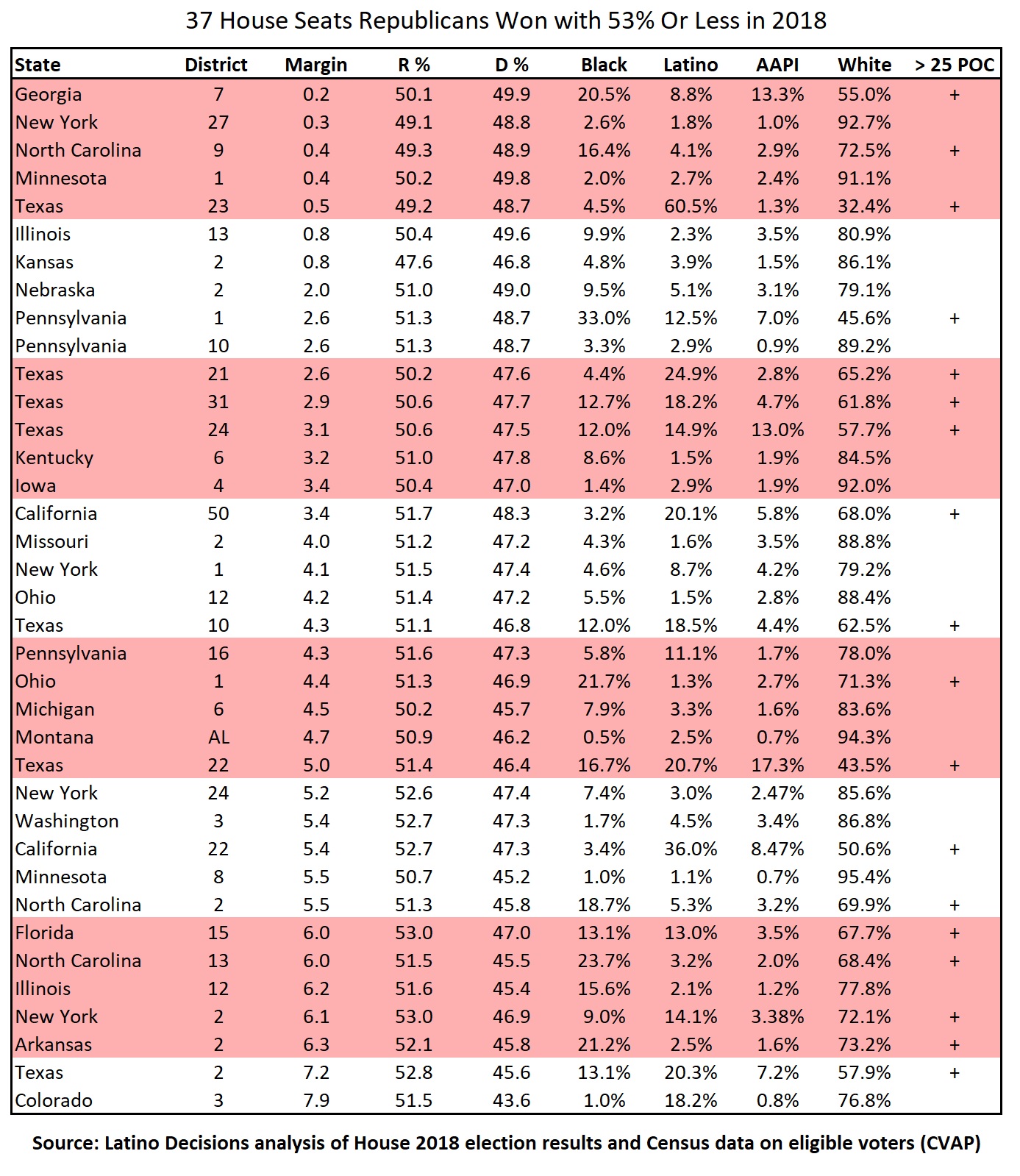When it comes to 2020, minority communities are likely to have a considerable impact beyond the Presidential election – the Democratic margin in the U.S. House will rise and fall with the minority vote.
From the 2018 midterm elections, we learned just how crucial communities of color were in changing the electoral map and composition of the U.S. House. With vote-share numbers resembling those of presidential elections, non-white voters were more engaged and mobilized in 2018 compared to any previous midterm elections. In total, among the 43 seats Democrats flipped from red to blue, in 24 of these districts the minority electorate was 25% or greater. This was not simply a case of winning over suburban white voters. These districts could not have flipped without strong turnout and strong Democratic vote among black, AAPI, and Latino communities.
Looking ahead to 2020, there were 37 House seats that Republicans narrowly won in 2018 – with 53% of the vote or less – and in 18 of these toss-up districts the minority electorate was larger than 25% in 2018, and likely higher in 2020.
Majority-Latino districts in particular showed large growth in terms of ballots cast, according to a report by the UCLA Latino Policy and Politics Initiative, which broke down Latino turnout in over 20,000 precincts across states with large Latino populations and found a 96% increase in votes cast among Latino precincts compared to a 37% increase in non-Latino precincts.
As the electorate becomes increasingly diverse, communities of color will continue to be influential in elections to come. A recent report on the projected structure of the 2020 electorate released by the Pew Research Center suggests that non-white voters will make up one-third of all eligible voters nationwide. Latinos are predicted to be the largest minority group (13.3%), followed by Black (12.5%), and Asian populations (4.7%).
This impact can be seen in the outcomes of the most competitive districts, where minority voters exceedingly voted for the Democratic candidate in their district, as seen in Latino Decisions American Election Eve Poll findings.
Democratic gains in 2018
Looking at the electoral outcomes in the House, Democrats gained 43 previously Republican-held districts, of which over half can be classified as minority-influence districts.

While Democrats saw increases in the White vote share, a majority of Whites voted Republican in 2018. Minority voters as a coalition had a great influence in flipping seats like Georgia’s 6th, where Democrats won by a narrow margin of only one percentage point, propelled by a minority electorate of over 30%.
Likewise, Virginia’s 2nd district was flipped by Democrats by a narrow margin of two percentage points, with a 36% non-white population largely driven by the Black community (24%). Other districts such as Texas-7 in the Houston suburbs show the strength of a combined minority vote which has an eligible voting population that is 20% Latino, 14% black and 12% Asian in which the Democrats carried by five points.
New York’s 11th district (Staten Island) faced a similar outcome, and was originally projected to remain under Republican control. Here, the Democratic candidate won by a margin of 6.4 points and whose minority communities accounted for one-third of the population. Even in non-traditional “minority-influence” states, growth in the combined minority vote flipped seats in districts such as Oklahoma-5 (25% minority) where Democrats won by just 1.4 points in 2018.
The Latino influence was particularly seen in districts like New Mexico’s 2nd, which was flipped by 1.8 percentage points and where 4 in 10 voters were Latino. Among the most prominent minority-influenced districts is California-21, where Latinos made up 55% of the eligible voting population, flipped red-to-blue by less than one point. In three other districts in Orange County, California it was Asian Americans who were the largest minority group that contributed to the blue wave in CA-39, CA-45, and CA-48.
Indeed, across 24 of the flipped districts, it was a combined minority vote that helped the Democrats gain control of the House, and if Democrats expect to keep these pivotal seats, they must continue their mobilizing and outreach efforts to engage minority voters as the DCCC and affiliated groups did in 2018.
Potential Pick up opportunities in 2020
On the other hand, Democrats have House pick-up opportunities where Republicans obtained only marginal wins.

In the most recent cycle, Republicans held on to 37 seats carrying 53% or less of the total votes. These 37 seats will certainly end up on red-to-blue target lists in 2020. Among these competitive districts, 18 of them can be classified as “minority-influence” with a Latino, Black, and AAPI potential electorate of over 25% of the total vote.
One of the most attainable seats in 2020 is Georgia’s 7th district, narrowly won by the Republican candidate by only 0.2 percentage points. Minority voters are poised to have considerable influence in flipping this seat in the next election, as 4 in 10 eligible voters are ethnic minorities. North Carolina’s 9th district, which may have a redo election in 2019 has a large black, Latino and Native American voting population totally about 28%.
When looking at turnout and demographic changes, Texas has perhaps the most potential for Democratic gains in 2020. Among the list of 37 narrow GOP wins, seven vulnerable House seats are in the state of Texas and all seven of these have minority voter populations of 35% or larger. Republicans won Texas-23 by a mere half a percentage point. With Latinos accounting for over 60% of the population, such margins make this district extremely competitive and viable for Democrats. Similarly, Democrats lost Texas’ 31st district by only 3 percent of the vote, a district where almost 4 in 10 voters are either Black, Latino, or AAPI.
In California, two additional seats with large minority electorates will be on the DCCC target list, CA-50 (32% non-white) and CA-22 (49% non-white).
Latino and other ethnic minority voters demonstrated very strong turnout rates in the 2018 midterm in districts where candidates made an effort to connect with, and relate to communities of color. While continued in-roads to moderate White voters will also be important, the greatest opportunity for Democrats is undoubtedly in minority communities that are continually voting 3-to-1 Democrat, and have the greatest potential for turnout increases as a result of decades of under-mobilization.
Democrats cannot rest on the seats they gained in 2018, as many of those wins were narrow and will be hard-fought in 2020. The sense of urgency in 2018 cannot be lost now that Pelosi controls the gavel in the House. If Democrats expect to keep the seats gained in 2018 and to target the GOP-vulnerable House seats in 2020, they will need to earn the vote of minority communities and to inspire record vote growth.


